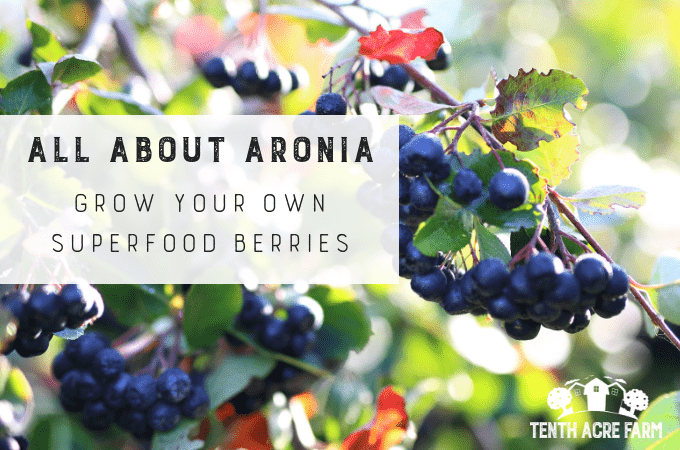All About Aronia: Grow Your Own Superfood Berries
Ready to grow your own superfood? Aronia shrubs are low-maintenance, widely adaptable to a variety of conditions, and yield a ‘superfood’ berry. Certainly worthy of a spot in the edible landscape.


This page may contain affiliate links. Please read my disclosure for more info.
I was delighted to come across aronia when taking a tour of a friend’s food forest. The shrubs were attractive, and he reported that they were low-maintenance and pest/disease-free. He had just finished planting a hedgerow of them to sell the ‘superfood’ berries at local farmers’ markets. It prompted me to want to learn more about them!
What is aronia?
Aronia is a berry-producing shrub that is native to eastern North America. Its common name is chokeberry, which doesn’t sound very enticing. Can you imagine coming across chokeberries in the supermarket?
Partly because of this unfortunate name, aronia fell out of favor in American kitchen gardens and edible landscapes. However, it was once a common and abundant foraging plant for Native Americans, who used the berries, leaves, and twigs in a variety of ways as medicine and for curing meats.
In the early 1900s, the plants from North America were introduced into Eastern European countries where they have thrived in popularity as a commercial crop. Poland is currently the world’s largest producer of aronia berries, exporting the majority of the crop to the United States as juice.
The irony of one of America’s native foods being imported commercially from Europe certainly makes you think about the globalization of the food system!
Want to grow fruits, vegetables, and herbs in your front yard landscape without sacrificing curb appeal? Check out my mini guide, The Permaculture Inspired Edible Landscape.
Aronia the Superfood
These berries burst onto the foodie scene in the last 20 years since they were discovered to be high in vitamin C and to have significantly more antioxidant properties than most fruit, including blueberries and even elderberries.
There isn’t an official scientific classification called “superfoods” (it’s more of a marketing term), nevertheless, there seems to be something healthy and good about the berry’s dark purple pigments.
Interestingly, agricultural scientists in Finland discovered that making jam from the berries was the best way to retain antioxidants compared to drying the fruit or juicing it.
In fact, the fruit is very astringent (mouth-puckering), so most people do not enjoy eating it fresh. However, if you mix aronia berries 1:1 with a sweeter fruit (Blueberry? Raspberry? Apple?), you’ll enjoy them very much in juice, wine, baking, jams and jellies, or in fruit smoothies.
Get more ideas for how to use aronia in my article about growing a jelly garden. Also check out my friend Sarah’s book The Fruit Forager’s Companion. She is a wealth of knowledge.


Aronia berries growing in the garden
Species of Aronia
Once its designation as a superfood was discovered, commercial growers became very interested in finding a better name than chokeberry. Defaulting to its Latin name aronia seemed like a wise choice.
There are three species that we know of so far, all native to North America:
- Black chokeberry (Aronia melanocarpa) is a small to medium-sized shrub with dark purple-black fruit.
- Red chokeberry (Aronia arbutifolia) is a large shrub with red fruit.
- Purple chokeberry (Aronia prunifolia) is a natural hybrid of red and black chokeberry.
Although all of the berries score high in antioxidant value, black chokeberry scores the highest.
Because of this designation, and because black chokeberry is said to be the more palatable berry of the bunch, it is the species that has exploded into commercial cultivation, as well as home gardens and landscapes across North America. Red chokeberry is on its heels as a beautiful addition to the landscape.
Where does aronia grow?
- Black chokeberry (Aronia melanocarpa) — Zone 3-8. It is native to eastern Canada and the United States. It spreads throughout the midwest, but does not venture into the southern states of Florida, Louisiana, or Texas. (See map here.)
- Red chokeberry (Aronia arbutifolia) — Zone 4-9. Red aronia is native to the eastern seaboard of Canada and the United States. It does not venture into the midwest, but it has been spotted in all of the southern states into Texas. (See map here.)
- Purple chokeberry (Aronia prunifolia) — Zone 4-7. Purple aronia can be found wherever the ranges of the other two species overlap.
*Note: This plant is not to be confused with ChokeCherry, which is a different species.


White flowers of aronia
Growing Aronia
The bushes are easy to grow and are attractive all season long. White blossoms decorate the plant in the spring, while dark green, glossy leaves adorn the bushes in the summer. Brilliant red leaves put on a show in the fall.
Black aronia berries ripen in mid-to-late summer, the purple berries after that, and the red berries ripen in the fall, all of which provide seasonal beauty as well. For all of these reasons, you can see why it has become a popular shrub for the edible landscape!
Aronia Bush Size
Native cultivars of black aronia grow 3-6 feet tall and 6-10 feet wide. ‘Nero’ is a popular variety that tends to stay smaller at 3-4 feet tall and wide. ‘Viking’ is taller for privacy hedgerows. There’s even a dwarf black aronia that stays 1-3 feet tall.
Red aronia has a taller, more upright growth habit, growing 6-10 feet tall and 3-5 feet wide. It has a tendency to get leggy over time, where the foliage and berries develop at the top of the shrub, with the undergrowth open without foliage. ‘Brilliantissima’ brings wonderful fall foliage and may not get as leggy as the wild plant.
Purple aronia grows 6-9 feet tall and wide.
New varieties — especially of black aronia — are being developed all the time that grow in varying conditions, are more compact for smaller landscapes, and grow more and bigger berries, so keep an eye out and always ask your local nursery specialists.
Tired of generic permaculture design advice that you can’t apply to your specific goals? If so, check out my Permaculture Design Program and get the tools and support needed to create and implement your own permaculture design.


Dwarf aronia (circled) in this landscape design by Our Land Organics
Photo by John Hemmerle of Our Land Organics
Aronia Growth Habit
The plant is adaptable to many types of growing conditions. Because it is self-pollinated by small bees, there is no need to worry about having both male and female plants. (The flowering shrubs in spring will be buzzing with tiny pollinators!)
Sun:
You’ll get the largest harvests in full sun, but these shrubs grow and produce fine in partial shade. After all, it is a thicket plant accustomed to part-sun conditions.
Soil and Moisture:
Aronia has been found growing in such varying conditions as low-lying swamps, wetlands, and soggy clay soil; as well as dry, sandy areas, rocky ridges, and pine woods. Ideally, plant it in rich, moist, well-draining soil, but don’t fret if you don’t have these conditions.
It even made my list of top edible perennials for wet soil and is a good choice for water harvesting techniques like rain gardens and swales.
Overall, this native shrub seems to be tolerant to drought and salt, as well as resistant to pests and diseases. Birds turn to the berries as a winter food source, while deer and rabbits may browse the young bushes. Consider caging them until they are well established.
Because of their low maintenance, relatively small growth habit, adaptability to various growing conditions, and their self-pollinating habit, aronia makes an excellent addition to a permaculture food forest.
For the adventurous: Apparently you can graft pear onto aronia. I read it in Edible Forest Gardens, so it must be true! 🙂 I’d love to know if you try this.


Aronia arbutifolia ‘Brilliantissima’
Aronia Shrub Maintenance
The shrub responds well to pruning if you’d like to keep it a certain size. Simply prune it during the dormant season like you would other woody perennials.
To keep the bushes producing large crops of the largest berries, prune out a few of the oldest, thickest canes every couple of years.


Red aronia ‘Brilliantissima’ fall foliage (photo by John Hemmerle of OurLandOrganics.org)
Radical Roots
Aronia grows and spreads by suckering, which allows the wild bushes to develop into colonies. This is excellent news if you’d like to use the plant in a hedgerow or privacy screen, since the suckers will fill in the row and create a dense planting. Read more about creating hedgerows here.
Similar to growing raspberries or blackberries, the suckers can be cut or mowed if they spread outside the area you’ve set aside for them.
But it is not usually a cause for concern. In general, aronia is not as vigorous as raspberries or blackberries. Plus, it is thornless, which makes maintenance more enjoyable than pruning brambles!
But here’s an even cooler fact: Aronia roots are thick and fibrous, forming a dense mat just under the soil surface. This fibrous root matter is excellent at holding soil in place and preventing soil erosion, which makes it a good selection for hillside plantings.
All in all, aronia shrubs are well adapted to many kinds of growing conditions and produce a low-maintenance ‘superfood’ berry. Certainly worthy of a spot in the edible garden.
Want to learn more about growing aronia commercially? This website has a lot of information.
Have you planted aronia in your food-producing landscape?
READ NEXT:









